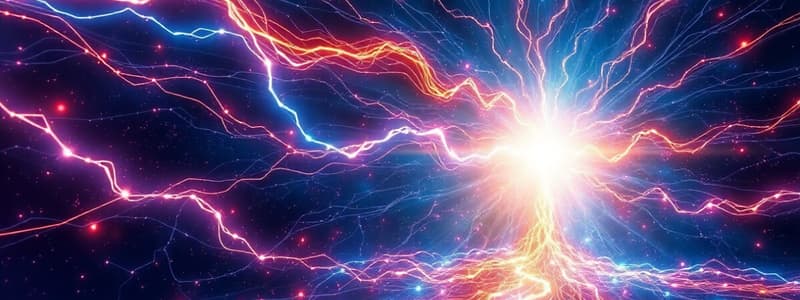Podcast
Questions and Answers
What describes the force between two point charges?
What describes the force between two point charges?
- Inverse square law of gravity
- Magnetic force equation
- Coulomb's Law (correct)
- Newton's first law
What is the correct nature of electric fields?
What is the correct nature of electric fields?
- Exist around charged objects (correct)
- Are caused only by magnetic fields
- Always have a north pole
- Can only be felt at very short distances
Which of the following statements accurately reflects Gauss's Law?
Which of the following statements accurately reflects Gauss's Law?
- It relates electric fields to charge distributions. (correct)
- It guarantees the existence of magnetic monopoles.
- It states that electric fields are never influenced by charge distributions.
- It asserts that electric field lines are closed loops.
How do electromagnetic waves travel?
How do electromagnetic waves travel?
What does Lenz's Law state about induced current?
What does Lenz's Law state about induced current?
What is the role of a generator in electromagnetism?
What is the role of a generator in electromagnetism?
Which law relates changing magnetic fields to electric fields?
Which law relates changing magnetic fields to electric fields?
What do magnetic field lines represent?
What do magnetic field lines represent?
What does Maxwell's Equations encompass?
What does Maxwell's Equations encompass?
What is the role of vacuum permittivity (ε₀) in electromagnetism?
What is the role of vacuum permittivity (ε₀) in electromagnetism?
Flashcards are hidden until you start studying
Study Notes
Electromagnetism
-
Definition: A branch of physics dealing with electric charges, magnetic fields, and their interactions.
-
Key Concepts:
- Electric Charge: Fundamental property of matter, existing in positive and negative forms.
- Coulomb's Law: Describes the force between two point charges; proportional to the product of the charges and inversely proportional to the square of the distance between them.
-
Electric Fields:
- Definition: A region around a charged object where other charges experience a force.
- Field Lines: Visual representation indicating the direction and strength of the electric field; directed away from positive charges and toward negative charges.
-
Magnetic Fields:
- Definition: A region around a magnet where magnetic forces can be observed.
- Field Lines: Represent the magnetic field; they exit from the north pole and enter the south pole of a magnet.
-
Electromagnetic Induction:
- Faraday's Law: A changing magnetic field within a closed loop induces an electromotive force (EMF) in the wire.
- Lenz's Law: The direction of induced current opposes the change in magnetic flux that produced it.
-
Maxwell's Equations: A set of four equations that form the foundation of classical electromagnetism.
- Gauss's Law: Relates electric fields to charge distributions.
- Gauss's Law for Magnetism: States that there are no magnetic monopoles; magnetic field lines are closed loops.
- Faraday's Law of Induction: Relates changing magnetic fields to electric fields.
- Ampère-Maxwell Law: Relates magnetic fields to electric currents and changing electric fields.
-
Electromagnetic Waves:
- Nature: Waves of electric and magnetic fields oscillating perpendicular to each other and the direction of propagation.
- Speed of Light: All electromagnetic waves travel at the speed of light in a vacuum, approximately (3 \times 10^8 \text{ m/s}).
-
Applications:
- Electric Motors: Devices that convert electrical energy to mechanical energy using magnetic fields.
- Generators: Convert mechanical energy to electrical energy via electromagnetic induction.
- Telecommunications: Use electromagnetic waves for transmitting information across distances (radio, microwaves, etc.).
-
Important Constants:
- Vacuum permittivity (ε₀): Reflects how electric fields interact in a vacuum.
- Vacuum permeability (μ₀): Reflects how magnetic fields interact in a vacuum.
- Speed of light (c): Related to electric and magnetic fields; (c = \frac{1}{\sqrt{ε₀μ₀}}).
-
Key Units:
- Electric Charge: Coulomb (C)
- Electric Field: Volts per meter (V/m)
- Magnetic Field: Tesla (T)
- Electric Potential: Volt (V)
Understanding these principles provides a comprehensive overview of electromagnetism and its significance in physics.
Electromagnetism Overview
- A branch of physics focusing on electric charges, magnetic fields, and their interactions.
Key Concepts
- Electric Charge: A fundamental property of matter, comes in positive and negative forms.
- Coulomb's Law: The force between two point charges; proportional to the product of the charges and inversely proportional to the square of the distance between them.
Electric Fields
- Definition: The area around a charged object where other charges experience a force.
- Field Lines: Visual representation showing direction and strength; they go away from positive charges and toward negative charges.
Magnetic Fields
- Definition: A region surrounding a magnet where magnetic forces can be observed.
- Field Lines: Indicate the magnetic field direction; they emerge from the north pole and curve toward the south pole.
Electromagnetic Induction
- Faraday's Law: A changing magnetic field within a closed loop induces an electromotive force (EMF) in the wire.
- Lenz's Law: The induced current's direction opposes the change in magnetic flux that caused it.
Maxwell's Equations
- A system of four foundational equations in classical electromagnetism:
- Gauss's Law: Connects electric fields to charge distributions.
- Gauss's Law for Magnetism: No magnetic monopoles exist; magnetic field lines are closed loops.
- Faraday's Law of Induction: Links changing magnetic fields to electric fields.
- Ampère-Maxwell Law: Relates magnetic fields to electric currents and varying electric fields.
Electromagnetic Waves
- Nature: Waves where electric and magnetic fields oscillate perpendicularly to each other and their propagation direction.
- Speed of Light: All electromagnetic waves travel at approximately (3 \times 10^8 \text{ m/s}) in a vacuum.
Applications
- Electric Motors: Convert electrical energy into mechanical energy with the help of magnetic fields.
- Generators: Transform mechanical energy into electrical energy through electromagnetic induction.
- Telecommunications: Utilize electromagnetic waves for long-distance information transmission (radio, microwaves, etc.).
Important Constants
- Vacuum permittivity (ε₀): Describes how electric fields behave in a vacuum.
- Vacuum permeability (μ₀): Describes the behavior of magnetic fields in a vacuum.
- Speed of light (c): Connects electric and magnetic properties; given by (c = \frac{1}{\sqrt{ε₀μ₀}}).
Key Units
- Electric Charge: Coulomb (C)
- Electric Field: Volts per meter (V/m)
- Magnetic Field: Tesla (T)
- Electric Potential: Volt (V)
Understanding these principles provides foundational insights into electromagnetism and its significance in physics.
Studying That Suits You
Use AI to generate personalized quizzes and flashcards to suit your learning preferences.




